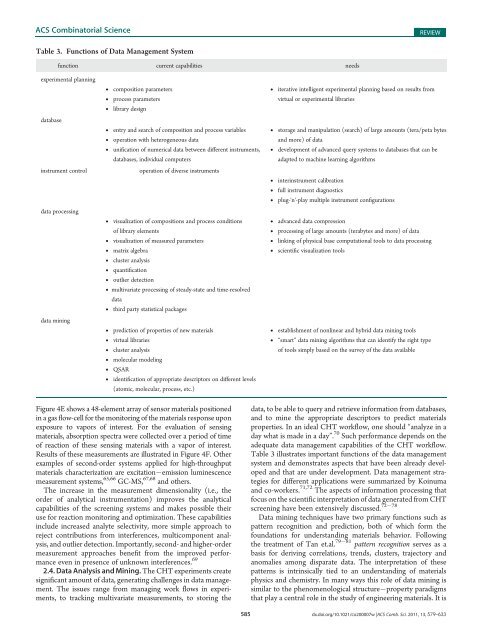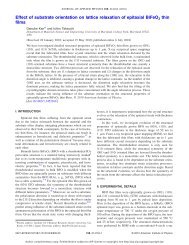Combinatorial and High-Throughput Screening of Materials ...
Combinatorial and High-Throughput Screening of Materials ...
Combinatorial and High-Throughput Screening of Materials ...
You also want an ePaper? Increase the reach of your titles
YUMPU automatically turns print PDFs into web optimized ePapers that Google loves.
ACS <strong>Combinatorial</strong> Science<br />
REVIEW<br />
Table 3. Functions <strong>of</strong> Data Management System<br />
function current capabilities needs<br />
experimental planning<br />
database<br />
instrument control<br />
data processing<br />
data mining<br />
• composition parameters<br />
• process parameters<br />
• library design<br />
• entry <strong>and</strong> search <strong>of</strong> composition <strong>and</strong> process variables<br />
• operation with heterogeneous data<br />
• unification <strong>of</strong> numerical data between different instruments,<br />
databases, individual computers<br />
operation <strong>of</strong> diverse instruments<br />
• visualization <strong>of</strong> compositions <strong>and</strong> process conditions<br />
<strong>of</strong> library elements<br />
• visualization <strong>of</strong> measured parameters<br />
• matrix algebra<br />
• cluster analysis<br />
• quantification<br />
• outlier detection<br />
• multivariate processing <strong>of</strong> steady-state <strong>and</strong> time-resolved<br />
data<br />
• third party statistical packages<br />
• prediction <strong>of</strong> properties <strong>of</strong> new materials<br />
• virtual libraries<br />
• cluster analysis<br />
• molecular modeling<br />
• QSAR<br />
• identification <strong>of</strong> appropriate descriptors on different levels<br />
(atomic, molecular, process, etc.)<br />
• iterative intelligent experimental planning based on results from<br />
virtual or experimental libraries<br />
• storage <strong>and</strong> manipulation (search) <strong>of</strong> large amounts (tera/peta bytes<br />
<strong>and</strong> more) <strong>of</strong> data<br />
• development <strong>of</strong> advanced query systems to databases that can be<br />
adapted to machine learning algorithms<br />
• interinstrument calibration<br />
• full instrument diagnostics<br />
• plug-'n'-play multiple instrument configurations<br />
• advanced data compression<br />
• processing <strong>of</strong> large amounts (terabytes <strong>and</strong> more) <strong>of</strong> data<br />
• linking <strong>of</strong> physical base computational tools to data processing<br />
• scientific visualization tools<br />
• establishment <strong>of</strong> nonlinear <strong>and</strong> hybrid data mining tools<br />
• “smart” data mining algorithms that can identify the right type<br />
<strong>of</strong> tools simply based on the survey <strong>of</strong> the data available<br />
Figure 4E shows a 48-element array <strong>of</strong> sensor materials positioned<br />
in a gas flow-cell for the monitoring <strong>of</strong> the materials response upon<br />
exposure to vapors <strong>of</strong> interest. For the evaluation <strong>of</strong> sensing<br />
materials, absorption spectra were collected over a period <strong>of</strong> time<br />
<strong>of</strong> reaction <strong>of</strong> these sensing materials with a vapor <strong>of</strong> interest.<br />
Results <strong>of</strong> these measurements are illustrated in Figure 4F. Other<br />
examples <strong>of</strong> second-order systems applied for high-throughput<br />
materials characterization are excitation emission luminescence<br />
measurement systems, 65,66 GC-MS, 67,68 <strong>and</strong> others.<br />
The increase in the measurement dimensionality (i.e., the<br />
order <strong>of</strong> analytical instrumentation) improves the analytical<br />
capabilities <strong>of</strong> the screening systems <strong>and</strong> makes possible their<br />
use for reaction monitoring <strong>and</strong> optimization. These capabilities<br />
include increased analyte selectivity, more simple approach to<br />
reject contributions from interferences, multicomponent analysis,<br />
<strong>and</strong> outlier detection. Importantly, second- <strong>and</strong> higher-order<br />
measurement approaches benefit from the improved performance<br />
even in presence <strong>of</strong> unknown interferences. 69<br />
2.4. Data Analysis <strong>and</strong> Mining. The CHT experiments create<br />
significant amount <strong>of</strong> data, generating challenges in data management.<br />
The issues range from managing work flows in experiments,<br />
to tracking multivariate measurements, to storing the<br />
data, to be able to query <strong>and</strong> retrieve information from databases,<br />
<strong>and</strong> to mine the appropriate descriptors to predict materials<br />
properties. In an ideal CHT workflow, one should “analyze in a<br />
day what is made in a day”. 70 Such performance depends on the<br />
adequate data management capabilities <strong>of</strong> the CHT workflow.<br />
Table 3 illustrates important functions <strong>of</strong> the data management<br />
system <strong>and</strong> demonstrates aspects that have been already developed<br />
<strong>and</strong> that are under development. Data management strategies<br />
for different applications were summarized by Koinuma<br />
<strong>and</strong> co-workers. 71,72 The aspects <strong>of</strong> information processing that<br />
focus on the scientific interpretation <strong>of</strong> data generated from CHT<br />
72 78<br />
screening have been extensively discussed.<br />
Data mining techniques have two primary functions such as<br />
pattern recognition <strong>and</strong> prediction, both <strong>of</strong> which form the<br />
foundations for underst<strong>and</strong>ing materials behavior. Following<br />
the treatment <strong>of</strong> Tan et.al. 79 81 pattern recognition serves as a<br />
basis for deriving correlations, trends, clusters, trajectory <strong>and</strong><br />
anomalies among disparate data. The interpretation <strong>of</strong> these<br />
patterns is intrinsically tied to an underst<strong>and</strong>ing <strong>of</strong> materials<br />
physics <strong>and</strong> chemistry. In many ways this role <strong>of</strong> data mining is<br />
similar to the phenomenological structure property paradigms<br />
that play a central role in the study <strong>of</strong> engineering materials. It is<br />
585 dx.doi.org/10.1021/co200007w |ACS Comb. Sci. 2011, 13, 579–633












